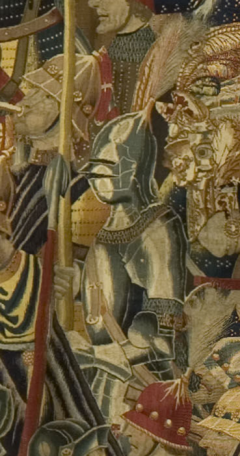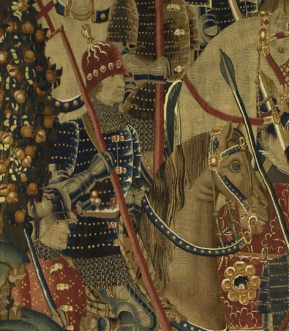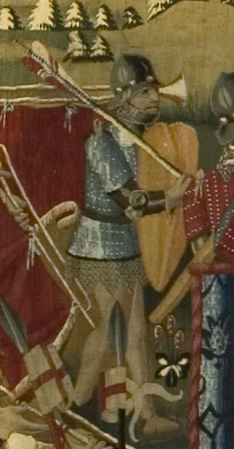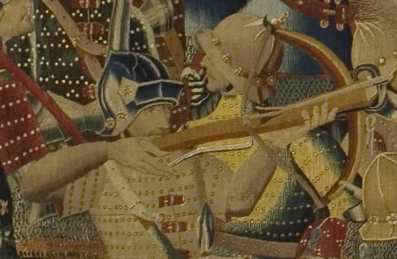Dada a extensão deste artigo, achei por bem publicar as versões inglesa e portuguesa em separado. Para a versão portuguesa, cliquem aqui.
No-one fights alone in the Middle Ages. Every warrior is part of a body of men, large or small, gathered with a single purpose: to wage war. From knights on their barbed steeds to the lowliest of levies, medieval men are links in an intricate weave – ‘the result of a congregation of a series of pieces with a high degree of autonomy’ [1]. For military-oriented reenactors such as myself, it is important to know where our personas fit in the middle of such a complex structure.
In this series of posts, I will endeavour to showcase the many different organisational units in which a late 15th century Portuguese warrior could find himself, and what we can draw from this information to improve our period portrayals. I shall begin today by presenting a very brief, very general overview of these units, without going into too much detail: who are these men, where do they come from, and what equipment do they tend to use?
The Royal Guard – The king’s men

Any self-respecting monarch has a group of men to protect him, and Portuguese kings are no exception.
Right up to the tail-end of the Middle Ages, Portuguese royal guards were informal gatherings of knights and crossbowmen: second children of the nobility, looking for their place in the sun (in the case of knights), or elites of the people, looking to get a foot on the social ladder (in the case of crossbowmen). In our period, the royal guard was organised according to a model created during the reign of King João I, in the early 15th century: a group of squires (never more than 80 men strong), led by a guarda-mor; and a group of 100 crossbowmen, the king’s ‘besteiros da câmara’ (lit. ‘crossbowmen of the chamber’), led by an anadel-mor. A brave bucket-load of people, paradoxically reduced in times of war – to only 20 faithful knights or squires, captained by a trusted nobleman, with the sole purpose of safeguarding the king day and night. The first official corps of royal guards, of 100 men, was only established in 1483, by João II (who seemed to have a knack for making enemies, and consequently had more of a need for them).
For our period, the equipment prescribed to these men was lighter than we might initially assume (understandable, considering they usually had to wear it all day long) : brigandines, sallets, war hats; maille voiders and maille skirts; arm harnesses, and little else. They would carry spears, swords, and adargas, as well as a handy dagger tucked or hanging from their belts.
Noble Levies – Knights and their men

We all know about knights in the Middle Ages, and there is no war without them. These men belonged to a high (the highest) social class, and they were (almost) invariably endowed with great holdings and privileges. These steel-clad, powerfully armed men-at-arms were at the core of any military campaign, worth as much (if not more) for their training and martial prowess, and for the men they brought with them to the battlefield, as for their harnesses and weaponry .
The nobility’s recruitment system was a top-down structure: the king (or a great lord, like a duke) paid a vassal of his (a nobleman) a certain amount, which that vassal had to then spend on a certain number of men. This group was called a ‘mesnada’, a levy. To help with this, or to show favour, the king (or great lord) could also gift his vassals arms and/or horses, to ensure their readiness in time of war. Where did these noblemen got their men from? From the men in their own lands, of course, the inhabitants of their domains, whom they were expected to arm with weapons and armour from their personal armouries. But quite often they also resorted to poaching acontiados (about whom we’ll read below) from the towns and cities’ enlistment rolls, and incorporated them into their own ranks.
In any case, on their own or accompanied by a sizeable host, knights were the most heavily armed elements in any Portuguese army: spear, sword, pollaxe or mace in hand, they were in the habit of turning in steel, from head to toe. Not always – no matter how dashing a full harness was, they were sometimes impractical in certain contexts (raids and looting parties in Morocco, for example). Therefore, parts of the full white harness were sometimes been replaced by lighter pieces – brigandines instead of cuirasses, or war hats instead of sallets and armets -, and some components were eschewed altogether – greaves, for example.
Ginete Companies – A new tactical corps

The upper echelons of society also produced the ginetes, the Portuguese version of the renowned light Iberian cavalry inspired by Muslim war traditions and the needs of war in North Africa: they were usually members of the lower nobility, who specialised in speedy deployment and lightning-face raids and (the so-called ‘almogaverias’).
Their equipment was lighter than that of the traditional heavy cavalry: instead of a full harness, they wore brigandines, often did away with greaves or lower leg protection, exchanged closed helmets (sallets, for example) for war hats, more suitable for breathing and seeing whilst running around and riding on horseback. The lance/spear and the adarga were their weapons of choice, along with swords.
The Military Orders – Forces of renown
The knights of military orders in Portugal – the Orders of Christ, of Avis, of Santiago (Saint James of the Sword), and the Portuguese branch of the Hospitallers – continued to take part in Portuguese campaigns at this time, though they did so in very small numbers. As with their noble counterparts, they are extremely well-equipped forces, similar in every aspect to the rest of Portugal’s heavy cavalry.
Acontiados – Men of the villages, towns and cities of Portugal

The bulk of late medieval Portuguese armies was made up of the inhabitants of the country’s urban spaces. These men were called acontiados – men whose income (their ‘contias’, lit. amounts) would be assessed. The more they had, the more they were obliged to have in terms of arms and armour, and the more they had to present in times of war. These obligations could range from a simple spear and a shield, for those with lower incomes, to full harnesses and horses, for the wealthier.
These differences in income notwithstanding, late 15th century documentation suggests that the average acontiado was required to have a sallet or war hat with its bevor, a brigandine, a maille skirt, voiders, and arm harnesses. Legs and hands were often left bare (go figure). Adargas and spears of varying sorts were the most popular and widespread weapons, along with swords, javelins, and other, rarer weapons (axes, maces, vouges and couteaux, etc.).
Besteiros do Conto – Elite marksmen

From the country’s towns and cities, too, came the Besteiros do Conto – a fixed number of crossbowmen, trained and well-equipped, each municipality needed to provide in wartime. Being a Besteiro do Conto came with certain associated duties, of course, but also with a great range of social and financial privileges. In our period, the Besteiros do Conto as a renowned corps within the Portuguese army were already in full decline (they would eventually be dissolved in 1498). Still, as one of the first proto-permanent corps in the country, they participated in every Portuguese military campaign during the 15th century.
A man recruited as a crossbowman was, by law, obliged to have a crossbow (either a garrucha crossbow – armed using a goat’s foot lever; or a polé crossbow – armed with a windlass) and a hundred quarrels (bolts). As for defensive equipment, it wasn’t much: brigandines, no doubt, some sort of head protection (sallets, with or without a visor, and war hats ); some maille, the occasional arm harness, the occasional bevor, and little else. In Portugal, unlike other countries, crossbowmen do not seem to have brought pavises to the field with them.
Handgunners and bombardiers – The gunpowder revolution

Finally, the great novelty of the late 15th century: handgunners. Well, I’m exaggerating a little bit. Portuguese armies had already included handgunners since the beginning of the century, so a novelty they were not. Still, it was only during the reign of Afonso V that these men – usually craftsmen – took on an important role in Portuguese campaigns – so much so that, at the end of the century, they replaced the Besteiros do Conto altogether. Along with handgunners, we also have artillerymen, or bombardiers, who operated heavy artillery. Along with their great military importance came, of course, a slew of socio-economic privileges – as good as, and sometimes even better, than those afforded to the Besteiros. Being nammed a handgunner was an enviable appointment in late 15th century Portugal.
In both cases, these troops must’ve been equipped rather lightly, more or less in line with the Besteiros: brigandines, war hats or sallets, some maille, scant pieces of plate armour. In addition to their colubretas (culverins) and arquebuses (they coexisted at this time), they would have little more than their everyday daggers, or at most, a sword or some such weapon.
Military Reenactment
What lessons can we take from this summary regarding military reenactment? Perhaps the most obvious is the existence of a set of defensive elements – brigandines and certain types of helmets (sallets, war hats) – that are common to almost everyone in Portuguese armies. We can consider these two elements as the bare minimums for a good portrayal of the era, which is both good and bad news. Bad news, because nowadays a good brigandine is a costly investment (adon’t fall for the siren song of cheap brigandines – they don’t exist for less than 800€); good news, because a brigandine is a much more versatile and applicable investment in Portugal than in other territories in Europe, given the wide range of personas it would lend itself to.
We can also easily observe the juxtaposition between a combatant’s social and military statuses. In other words: mo ‘money, mo’ problems. Can we portray a rich merchant, full decked out in silks and brocades, but then barely have a gambeson and a dagger? No. Can we portray a lowly peasant, but then turn up to the field in a full harness? Of course not.
Like every warrior in the midst of a throng, every weapon and armament is a link in a chain, a piece of thread in the tapestry of an individual portrayal. Without the appropriate choices, it is impossible to flesh History out in all its nuances.
[1] ‘(…) o resultado da congregação de uma série de parcelas com elevado grau de autonomia’ [my translation]. In Monteiro, J. G. (1998). A Guerra em Portugal nos finais da Idade Média. Lisboa: Editorial Notícias, p. 27.
BIBLIOGRAPHY
Barroca, M. J. and Monteiro, J. G. (Coords.) (2000). Pera Guerrejar – Armamento Medieval no Espaço Português. Palmela: Câmara Municipal de Palmela
Dias, D. (2014). As Cortes de Coimbra e Évora de 1472-73 – Subsídios para o estudo da política parlamentar portuguesa [master’s dissertation]. Coimbra: Faculdade de Letras da Universidade de Coimbra
Monteiro, J. G. (1998). A Guerra em Portugal nos finais da Idade Média. Lisboa: Editorial Notícias
Sebastião, P. (2018). Os espingardeiros – Um novo corpo militar no alvor da modernidade (1437-1495) [master’s dissertation]. Coimbra: Faculdade de Letras da Universidade de Coimbra
Tavares, J. (1987). Guerreiros Medievais Portugueses: Peonagem. Lisboa: Verbo
Teixeira, N., and Barata, M. (2003). Nova História Militar de Portugal (Vol. I). Rio de Mouro: Círculo de Leitores
VISUAL SOURCES
(ca. 1475). Siege of Asilah [wool and silk]. Tapestry. Pastrana: Parish Tapestry Museum. Retrieved from http://tapestries.flandesenhispania.org/index.php/Siege_of_Asilah_(Cerco_de_Arcila)
(ca. 1475). Disembarkation in Asilah [wool and silk]. Tapestry. Pastrana: Parish Tapestry Museum. Retrieved from http://tapestries.flandesenhispania.org/index.php/Disembarkation_in_Asilah_(Desembarco_en_Arcila)
(ca. 1475). The Taking of Tangier [wool and silk]. Tapestry. Pastrana: Parish Tapestry Museum. Retrieved from http://tapestries.flandesenhispania.org/index.php/The_taking_of_Tangier_(Toma_de_T%C3%A1nger)
(ca. 1475). Assault on Asilah [wool and silk]. Tapestry. Pastrana: Parish Tapestry Museum. Retrieved from http://tapestries.flandesenhispania.org/index.php/Assault_on_Asilah_(Asalto_de_Arcila)

One thought on “Military Organisation in Portugal during the late 15th Century – I”